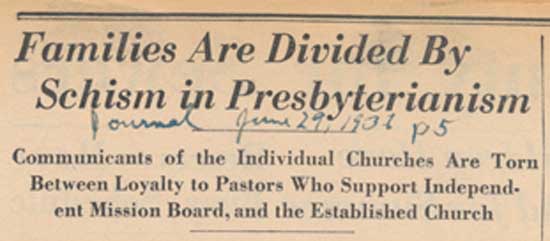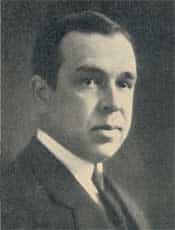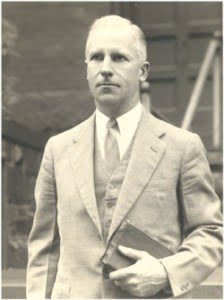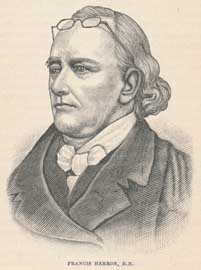Just a few days ago, we looked briefly at the life and ministry of the Rev. Dr. Francis Herron. This Lord’s Day we present the sermon delivered by the Rev. William M. Paxton, in 1861, on the occasion of Dr. Herron’s death. In good 19th-century fashion, the sermon is in places somewhat flowery to modern sensibilities. Still, it provides a good example of an appropriate sermon for a significant pastor, one who was greatly used of the Lord.
“My Father, My Father, the chariot of Israel and the horsemen thereof.“–2 Kings 2:12.
Never, perhaps, had the name Father been uttered in deeper grief, or with warmer affection.
Elijah, the Prophet Father and Elisha, the Prophet Son, were bound together by no ordinary ties of endearment. When it became manifest to the old Prophet that he must ere long retire from his sacred office, and i was indicated as the will of God that Elisha should fill his place, Elijah sought him, and, throwing his own mantle upon him, indicated and installed him as his successor. Accordingly, Elisha bade farewell to the home of his youth, and crossed the mountains of Gilead to take part in the ministry of the old Prophet, and to comfort and cheer him with the ready offices of kindness and affection. From that time they lived and labored together in the intimacy of a harmonious fellowship and reciprocated attachment. It was no ordinary friendship that bound them to each other. They had one interest, one aim, one motive, one sphere of blessed, holy, consecrated action; but deeper than this was the affinity of congenial temperament, the unity of kindred sympathies, the harmony of feeling strung to the same key; and deeper still, the affiance of grace, the common experience of the love of God, and the endearing intimacy of spiritual fellowship and communion which bound them together, heart and soul–wedding age and youth with a bond of perfectness.
The life of Elijah was spared longer than he seemed at first to anticipate. It was doubtless so ordered in mercy to Elisha. He needed the experience of age to direct him, and the wisdom and instructions of the old Prophet to prepare and mature him for his future responsibilities. For a period of about ten years this happy association and co-operation in the work of God continued; but now at last the time arrived when they must part, Elijah to ascend into glory, and Elisha to bear the responsibilities of the sacred office alone.
When it became known in the school of the Prophets at Jericho, that Elijah was about to finish his earthly course, it awakened such a painful interest among the young men in training there for the work of God, that a band of fifty followed after the two Prophets, as they took their course toward the Jordan, and ascending an eminence that overlooked the Valley, witnessed the sublime scene that followed. The Jordan parts before the stroke of Elijah’s mantle, and now they stand upon the opposite shore–the Prophet Father and the Prophet Son in their last act of earthly communion. Elijah with an overflowing heart, tells Elisha to present now his last request: “Ask what I shall do for thee before I am taken away from thee.” Elisha had no difficulty in fixing upon his request. One great thought now filled his mind–anxiety about the cause of God after Elijah was gone. Hence he instantly replies: “I pray thee let a double portion of thy spirit be upon me.” But whilst they were talking, “behold there appeared a chariot of fire, and horses o fire, and parted them both asunder, and Elijah went up by a whirlwind into heaven.”
And now, Elisha stands alone. Oh, who can tell the solitary desolation of his spirit at that moment? The Friend, the Father, the Counsellor to whom he had always looked, is gone. He had never before been left to himself. Elijah had always been at his side. Did he need direction? Elijah was there. Had he a sorrow? Elijah’s heart was full of sympathy. Had he a joy? it was repeated in the joy of Elijah. But now, alas! he is alone, without his helper; solitary, without his comforter. With streaming eyes he follows the receding chariot, till his grief bursting into language he exclaims: “My Father, My Father, the chariot of Israel and the horsemen thereof!” It was the expression of his own personal grief. It was the deep outgushing of a stricken heart–the sorrow of one who felt that his earthly comforts, stays and supports had all been severed in one sad blow. “The mantle of the ascending Prophet, loosed by an invisible hand, had fallen from his shoulders, and it floated down before him heavy laden with an official appointment, cast to him as it were out of the open heavens.” He felt, therefore, that he was not only alone, but alone under the weight of accumulated responsibilities. He was now to carry on the work of God single handed, to bear the burden of the sacred office without a helper, and added to all this, he had to assume the cares and responsibilities of instruction and government in the schools of the Prophets.
This is, therefore, the language of a heart greatly burdened, and pouring out in this single exclamation its great surge of responsibility and grief.
But to this language of personal sorrow, he adds also that of religious and patriotic lamentation: “THE CHARIOT OF ISRAEL AND THE HORSEMENT THEREOF.” The thought was evidently caught from the scene before him; and the idea is, that whilst Elijah had been to him a father, he had been to Israel, to the Church and the Nation, a chariot and a horseman. His labors and prayers had been of more value than military defences. He had done more by his counsels and intercessions for the protection and security of his country than chariots and horsemen. Whilst he had lost a Father, Israel had been bereaved of its strength and security. Hence he combines the expression of personal sorrow, with that of religious and national lamentation. He was bereft of a Father, the Church of a Prophet, and the nation of a Defender.
Now, my dear friends, all this is only too vividly realized in the bereavement that hangs this pulpit in mourning, and fills this church and community with sorrow.
This language of Elisha is only too apposite to the occasion. Whilst it describes by a remarkable coincidence, and with a striking minuteness of detail, the relation of the speaker to his departed Father and Counsellor, it is almost equally applicable to this whole assembly. He was the Father of this congregation—indeed of a whole family of congregations in and around these cities. The spiritual Father of multitudes here assembled, and perhaps the Father’s Father of many. The Father who witnessed your Father’s vows, and sprinkled upon you the water of baptism. The Father who instructed your childhood; solemnized your marriage covenant; received you into the family of Jesus; counseled at your fire-side; prayed with you in sickness, and brought comfort and tranquility amid the storms of affliction and bereavement. He was the aged Patriarch to whom this whole community did obeisance, and before whose venerable and majestic form even the stranger was ready to pause and say in Eastern phrase, “O King, live forever!” We may, therefore, adopt this language as the expression of our common sorrow, and as we look upward and trace the radiant pathway along which he passed to glory, exclaim, “My Father, My Father!”
But we may also add, this expression of religious and patriotic grief: “THE CHARIOT OF ISRAEL AND THE HORSEMEN THEREOF!” for whilst we have lost a Father, the Church has lost an able Minister, a wise and influential Presbyter, venerable for character and office, well known in all Israel; and the nation a patriot citizen, who had caught the spirit of liberty fresh from his Revolutionary Sire, whose heart was true to the union of these States, and whose counsels and prayers in this day of our country’s danger would have been of more value than chariots and horsemen. We may all, therefore, like Elisha, mingling together our personal, our religious and patriotic lamentation, exclaim: “MY FATHER, MY FATHER, THE CHARIOT OF ISRAEL, AND THE HORSEMEN THEREOF!”
It may gratify our feelings of personal sorrow to recount the events of his life, and deepen our conviction of the loss which the Church and the Nation has sustained, to estimate his character and worth.
From here, Rev. Paxton turned to a narrative of the life of the Rev. Dr. Francis Herron. Click here to continue reading his sermon. The remainder of the sermon continues from page 23 of the memorial.
Two Discourses upon The Life and Character of the Rev. Francis Herron, D.D., by the Rev. William M. Paxton, D.D., Pastor of the First Presbyterian Church, Pittsburgh. Preached and Published at the Request of the Board of Trustees and the Session of the Church. Pittsburgh: Robert S. Davis, No. 93 Wood Street, 1861. Press of W. G. Johnston & Co.





